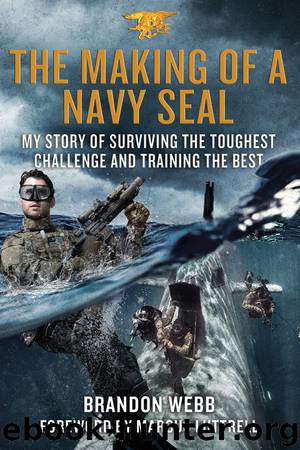The Making of a Navy SEAL by Brandon Webb

Author:Brandon Webb
Language: eng
Format: epub
ISBN: 9781466878334
Publisher: St. Martin's Press
CHAPTER THIRTY-THREE
Once we had mastered the M14 we moved on to other weapons, starting with the .308 bolt-action Remington, a very solid weapon and quite capable, in the right hands, out to eight hundred or nine hundred yards. This was our first look at a real scoped weapon—and right away, I knew I had a problem. There was a Leupold scope on one of my guns that just didn’t seem quite right. I pretty quickly realized that it wasn’t maintaining at zero. It was slipping off. There was no way I could shoot with a scope that wasn’t reliable.
These weapons are not delicate; they’re made to withstand the rigors of combat. However, they are pieces of precision machinery, and they’re not infallible. For example, the barrel of a .300 Win Mag is only good for a few thousand rounds, and then you shoot out the barrel and it starts losing accuracy. We were shooting thousands and thousands of rounds.
If your gun starts to malfunction in the middle of a shooting evolution, the instructor might assume it’s you. In a lot of cases, he’s right. In some cases, though, the weapon really is shot out, or there’s some kind of equipment malfunction. We had a few guys who were excellent shots but got flushed out of the course because they had the bad luck of getting a weapon that didn’t have a good log and was legitimately shot out, and they didn’t yet have the skills or know-how to deal with it right away.
I was determined not to let that happen. My first shooting test was coming up. No way was this faulty scope going to flush me from sniper school. I told my instructors about it, and when they didn’t do anything I kept bringing it up. I wouldn’t let it rest. Finally they got an armorer out there from the navy’s ordnance testing division. He looked at the scope and said, “Yeah, you have a bad optic.”
What a relief. I easily could have flunked out in my first test because of a messed-up scope.
At the same time that we started working with scopes on the .308, we also started working in pairs, taking turns as shooter and spotter. The shooter’s job is to put everything else out of his mind, take the information the spotter feeds him, and make a perfect shot, period. As we soon learned, the spotter’s job is in many ways more complex and more difficult.
As spotter, you are on the spotting scope, identifying and monitoring the target. Your job is to calculate windage and give target lead if necessary (that is, how much to compensate for the target’s movement). As spotter you also watch the shot trace, which tells its own story and either proves the call dead-on accurate or gives important clues for correcting the next shot. Yes, even though it is traveling at speeds of two thousand feet per second or more, you actually watch the thing. In most cases you can literally see those vapor trails all the way in to the target.
Download
This site does not store any files on its server. We only index and link to content provided by other sites. Please contact the content providers to delete copyright contents if any and email us, we'll remove relevant links or contents immediately.
Adulting by Kelly Williams Brown(4487)
Pocahontas by Joseph Bruchac(4182)
Unfiltered by Lily Collins(3958)
In the Shadow of Liberty by Kenneth C. Davis(3336)
Earthrise by Edgar Mitchell(3010)
Almost Adulting by Arden Rose(2663)
Charlie and the Chocolate Factory (Puffin Modern Classics) by Roald Dahl(2387)
Borders by unknow(2229)
The Audition by Maddie Ziegler(2157)
Fierce by Aly Raisman(2157)
I Will Always Write Back by Martin Ganda(2107)
Women in Science by Rachel Ignotofsky(1665)
Amelia Earhart by Doris L. Rich(1648)
The Day the President Was Shot by Bill O'Reilly(1588)
The Last Days of Jesus by Bill O'Reilly(1543)
Redefining Realness by Janet Mock(1513)
God's Smuggler by Brother Andrew(1509)
Extraordinary, Ordinary People by Condoleezza Rice(1468)
Popular: Vintage Wisdom for a Modern Geek by Maya Van Wagenen(1428)
